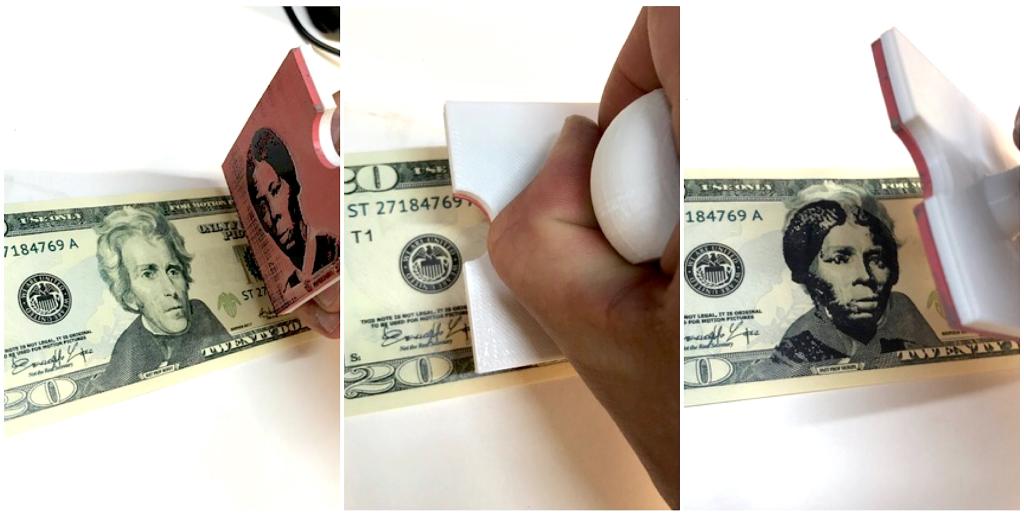Why we need Harriet Tubman on the $20 bill
Artist Dano Wall designed a stamp campaign which puts Harriet Tubman on the $20 bill after the move was blocked by the Trump administration. Find out how and why he came up with this idea.

On April 20, 2016, then-U.S. Treasury Secretary Jack Lew announced plans to add Harriet Tubman to the front of the revised twenty-dollar bill, moving President Andrew Jackson to the rear. Lew instructed the Bureau of Engraving and Printing to expedite the redesign process, and the new bill was expected to enter circulation sometime after 2020.
The day after, on April 21, 2016, Donald Trump was interviewed on the Today Show. He made his intentions clear: "Andrew Jackson had a great history and I think it's very rough when you take somebody off the bill. Andrew Jackson had a history of tremendous success for the country.... I would love to leave Andrew Jackson and see if we can maybe come up with another denomination. Maybe we do the $2 bill or we do another bill. I don't like seeing it." In early 2017, shortly after taking office, the Trump administration officially announced it would no longer be revising the $20 bill. In response, I designed a stamp that replaces Andrew Jackson's face with hers and began a campaign to stamp as many $20s as I could.

This project is important to me not simply because of its current political relevance, but also because it highlights a deeper issue of representation that runs through our country's history. The ubiquity of currency makes it a powerful vector through which the mentality of white supremacy is able to continue to permeate our culture. Putting Harriet Tubman on the front of the $20 bill would have constituted a monumental symbolic change, disrupting the pattern of white men who appear on our bills and, by putting her on the most popular note currently in circulation, indicate exactly what kind of a life we choose to celebrate; what values we, as a country, most hope to emulate. Harriet Tubman’s unparalleled grit, intelligence, and bravery over the course of her long life certainly make her worthy of such an honor.
How the stamp works
The impact that seeing the face of Harriet Tubman staring back at you from a $20 bill should not be underestimated. Who we choose to honor as a society affects the moral attitudes that are baked into us as we grow up, and this sort of representation can subtly but deeply affect someone's conception of themselves and their place within society. Although the connections may not seem immediately obvious, representation and equity are issues intimately connected to larger problems we face such as homelessness, common sense gun reform, clean drinking water, even saving coral reefs.
The notable lack of representation on our country’s currency has ripple effects through all levels of society, perpetuating the idea of monocultural government, and ultimately leaves behind voices and ideas from underrepresented populations that could improve the quality of life for everyone in this country. A society incapable of accurate self-representation does not inspire confidence in its capacity to solve challenges that impact all of its citizens.
Additionally, the political tools necessary to deal with unequal representation are the same that must be leveraged to fight the collective harms of racism, intolerance, and hate, so when we decline to address issues of representation we simultaneously dampen our potential to enact change. For these reasons I see putting Harriet Tubman on the $20 not as a trivial issue to be forgotten, but one of profound significance, worthy of continually pushing back into the spotlight. It is my hope to see Tubman $20s entering circulation in sufficient numbers to make it impossible to avoid a conversation about the proposed, now abandoned, plan to put Harriet Tubman on the $20 bill, and ultimately exert pressure on those with the power to make that change.
The design for this stamp has been made freely available online under a Creative Commons License for anyone wishing to make their own, and stamps are also available for purchase through this online shop. On the question of legality, the law states that though anti-counterfeiting laws prohibit the willful destruction of, and stamping of advertisements upon, paper money, pursuant to I.I.18 U.S.C. § 333 of the United States Code, stamped currency is fit for circulation so long as its denomination remains legible. More detailed information about the laws regarding currency stamping can be found here.
